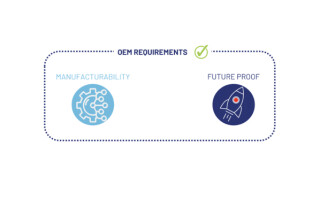AI & Machine Learning
AVerMedia Demonstrates AI-Driven Energy Conservation and GenAI Innovation at Embedded World 2024 in Nuremberg
April 10, 2024
Multimedia

Embedded Executive: Proprietary Vs. Open AI Ecosystems, Infineon
April 10, 2024
AI MCU vendors have mostly been putting themselves into two camps when it comes to the ecosystem. On one side, the vendor is providing everything themselves. In the other camp, the vendor is relying on partners and the community at large to provide the ecosystem. I recently spoke to Steve Tateosian, SVP of Industrial MCUs, IoT, Wireless, and Compute Business at Infineon, as the company just announced a bunch of AI MCUs and I wanted to find out which camp he was residing in. Find out on this week’s Embedded Executives podcast.
AI & Machine Learning
-
embedded world 2024 Best in Show Honorable Mention
April 08, 2024
-
embedded world 2024 Best in Show Winners
April 08, 2024
-
Visidon AI-Powered Low-Light Video Enhancement Selected to Hailo-15 AI Vision Processor
April 05, 2024
-
Embedded Executive: Partnerships Can Simplify Complex AI Designs, with Renesas and EdgeCortix
April 03, 2024
Automotive
-
NXP Releases its Open S32 CoreRide Platform Simplifying SDV Development
March 28, 2024
-
Cadence Expands Tensilica Vision Family with Radar Accelerator and New DSPs for Automotive Applications
March 11, 2024
-
Ethernovia Unveils Single and Quad Port, 10G to 1G Automotive PHY in 7nm
March 05, 2024
-
Scoping Out the Software-Defined Vehicle: The Benefits of OTA Updates & Open Source
February 23, 2024
Consumer
-
Software-Defined Displays: The Secret Sauce for AR Smart Glasses
March 26, 2024
-
Lighter, Clearer, and More Immersive – How the Waveguide – Light Engine Combination Transforms Our View of AR Smart Glasses
March 20, 2024
-
Seeing Beyond Reality: What Are the Key Requirements That Define AR Smart Glasses' Success?
March 18, 2024
-
Wireless Haptic Vest Creates Immersive Experiences for Virtual Reality
March 15, 2024
Healthcare
-
RTLS and Mobile Medical Equipment: How Hospitals Can Prevent Critical Assets from Going Missing
January 15, 2024
-
Engineering Hero: Bringing Prosthetic Arms to Life
December 28, 2023
-
Engineering Hero: The Bright Future of Bionic Limb Prosthetics
December 27, 2023
-
Engineering Hero: Treating Brain Cancer by Targeting Mutations
December 20, 2023
IoT
-
Gateways & Nodes for Raspberry Pi, Pico, Espressif, and More
April 15, 2024
-
Efinix Introduces its Titanium Ti375 High-Performance FPGA
April 12, 2024
-
NVIDIA Powered 5G Edge AI Gateway from Lanner
April 11, 2024
-
AntennaWare to Launch Innovative New Range of BodyWave™ UWB Antenna at Embedded World 24
April 05, 2024
Storage
-
New Greenliant eMMC and NVMe BGA SSDs on Display at embedded world 2024
April 05, 2024
-
embedded world 2024 Best in Show Nominees: Memory & Storage
April 01, 2024
-
Celebrate World Backup Day: Embed Resilience in Your Own Digital Future
March 28, 2024
-
Road to embedded world: Exascend Bringing Mission Critical Rad-Hard Storage Solutions
March 27, 2024
Processing
-
Embedded Executive: Proprietary Vs. Open AI Ecosystems, Infineon
April 10, 2024
-
Road to embedded world: MIPS Unlocks Power of Edge AI Through Data Movement
April 09, 2024
-
2024 embedded world Product Showcase: Synaptics’ SL-Series of Embedded IoT Processors
April 08, 2024
-
2024 embedded world Product Showcase: BeagleBoard.org Foundation’s BeagleY®-AI
April 08, 2024
Software & OS
-
LDRA Released its Domain-Specific Software Productivity Packages for the LDRA Tool Suite
April 12, 2024
-
RTOS Functional Safety Certification – Table Stakes or not?
April 11, 2024
-
Embedded Computing Design Announces PTC Perc Real-Time Java Wins embedded world Best in Show Award
April 09, 2024
-
Visuality Systems Showcases YNQ at Embedded World 2024
April 05, 2024

























